
npj Materials Degradation
Scope & Guideline
Advancing Sustainability Through Material Insights
Introduction
Aims and Scopes
- Corrosion Mechanisms and Prevention:
Research on the fundamental mechanisms of corrosion in various environments, including electrochemical processes, localized corrosion, and the role of environmental factors. This area also includes studies on corrosion inhibitors and protective coatings. - Material Characterization and Performance:
Extensive analysis of materials' properties, including mechanical, thermal, and electrochemical characteristics, especially under degradation conditions. This encompasses both experimental and computational methods. - Biodegradation and Environmental Interactions:
Exploration of how materials interact with biological systems and environmental conditions, particularly in relation to biodegradation processes and microbiologically influenced corrosion. - Innovative Coatings and Treatments:
Development of novel materials and surface treatments aimed at enhancing corrosion resistance, such as smart coatings, self-healing materials, and nanocomposite coatings. - Machine Learning and Computational Approaches:
Utilization of machine learning and computational techniques to predict corrosion behavior, optimize materials design, and analyze degradation processes.
Trending and Emerging
- Machine Learning in Corrosion Prediction:
The application of machine learning techniques to predict corrosion behaviors and optimize materials is trending. This reflects a growing interest in data-driven approaches to enhance understanding and management of material degradation. - Bioinspired and Self-Healing Materials:
There is an increasing focus on developing bioinspired materials and self-healing coatings that can autonomously repair damage. This trend is driven by the need for sustainable and long-lasting materials in various applications. - Advanced Coating Technologies:
The exploration of advanced coating technologies, including multifunctional and nanostructured coatings, is on the rise. These coatings aim to provide enhanced protection against corrosion and degradation, often incorporating novel materials and methodologies. - Environmental Impact and Sustainability:
Research addressing the environmental impact of materials and degradation processes is emerging as a vital theme, reflecting a broader societal push towards sustainable practices in materials engineering. - Corrosion in Additive Manufacturing:
The study of corrosion behaviors in additively manufactured components is gaining prominence, as this technology becomes more prevalent in various industries, necessitating a better understanding of the unique degradation mechanisms involved.
Declining or Waning
- Traditional Corrosion Testing Methods:
There is a noticeable decrease in publications focused on conventional corrosion testing methods, as newer technologies and computational models gain popularity and provide more efficient and insightful data. - Generalized Studies on Common Alloys:
Research on widely used alloys without specific contextual applications is declining. The emphasis is shifting towards more specialized and innovative materials that meet specific environmental and operational challenges. - Surface Treatment Techniques:
Studies on classical surface treatment techniques are becoming less frequent, as research moves towards more advanced and multifunctional coatings that integrate properties such as self-healing and environmental responsiveness.
Similar Journals
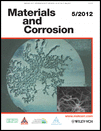
MATERIALS AND CORROSION-WERKSTOFFE UND KORROSION
Advancing the Science of Materials and CorrosionMATERIALS AND CORROSION-WERKSTOFFE UND KORROSION, published by WILEY-V C H VERLAG GMBH, stands as a pivotal resource in the fields of materials science and engineering. Established in 1950, this peer-reviewed journal publishes innovative research that advances our understanding of materials performance and degradation in various environments. With a commendable impact factor and notable rankings in several categories—including Q2 in Materials Chemistry and Mechanical Engineering—the journal attracts submissions from leading researchers worldwide. It encompasses a diverse range of topics related to metals, alloys, surfaces, coatings, and environmental impacts, thereby serving a broad audience of scholars and professionals. The journal offers both subscription and Open Access options, ensuring that significant research findings are readily available to all. With its commitment to fostering knowledge and collaboration, MATERIALS AND CORROSION plays a crucial role in addressing the evolving challenges in material science and corrosion management.

CORROSION ENGINEERING SCIENCE AND TECHNOLOGY
Connecting academia and industry in corrosion advancements.CORROSION ENGINEERING SCIENCE AND TECHNOLOGY is a pivotal journal dedicated to the exploration and advancement of corrosion knowledge and technologies, published by SAGE Publications Inc. This esteemed journal holds an ISSN of 1478-422X and an E-ISSN of 1743-2782, and is available for access in the United Kingdom and beyond. With a converged timeline from 2003 to 2024, it continues to publish high-quality research, fostering innovation in the fields of Chemical Engineering, Chemistry, and Materials Science, currently ranked in the Q3 quartile in these categories as of 2023. Additionally, the journal's Scopus rankings—211th in General Chemistry, 145th in General Chemical Engineering, and 266th in General Materials Science—underscore its commitment to disseminating impactful research. As an open-access journal, it invites researchers, professionals, and students to engage with cutting-edge developments in corrosion science, offering insights and solutions critical to numerous industries and enhancing collective academic understanding.

Protection of Metals and Physical Chemistry of Surfaces
Pioneering Research for Enhanced Material DurabilityProtection of Metals and Physical Chemistry of Surfaces is a prominent academic journal published by MAIK NAUKA/INTERPERIODICA/SPRINGER, which provides a specialized platform for researchers and professionals in the fields of materials chemistry, metals and alloys, organic chemistry, as well as surfaces, coatings, and films. With an ISSN of 2070-2051 and an E-ISSN of 2070-206X, the journal is recognized for its rigorous peer-reviewed content and comprehensive coverage of innovative research addressing the latest advancements in material protection and surface chemistry. As of 2023, the journal has been categorized in the Q3 quartile across several relevant fields, highlighting its increasing influence within the scientific community. Although the journal is relatively niche, its open access model encourages wide dissemination of knowledge, fostering collaboration and advancements within its core disciplines. Research published in this journal plays a crucial role in not only enhancing theoretical understanding but also facilitating practical applications in various industries, thereby underlining its importance for students, researchers, and professionals alike.
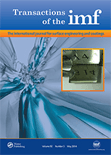
TRANSACTIONS OF THE INSTITUTE OF METAL FINISHING
Unveiling Breakthroughs in Metal Finishing TechniquesTRANSACTIONS OF THE INSTITUTE OF METAL FINISHING, published by Taylor & Francis Ltd, is a premier journal dedicated to the field of metal finishing and surface engineering. With an ISSN of 0020-2967 and E-ISSN of 1745-9192, this journal has been a critical resource for researchers and practitioners since its inception in 1969. Covering a broad scope that includes condensed matter physics, mechanics of materials, and the intricate science of metals and alloys, TRANSACTIONS OF THE INSTITUTE OF METAL FINISHING has established itself within the academic community, currently holding Q2 and Q3 rankings across multiple relevant categories in 2023. While not openly accessible, the journal remains a vital compendium of innovative research findings and advancements, attracting contributors and readers eager to explore cutting-edge developments in metal finishing techniques and applications. The insightful articles published here cater to a wide audience, including industry professionals, academic researchers, and students, who seek to improve their understanding of materials science and engineering practices.

CORROSION SCIENCE
Elevating corrosion science for a sustainable future.CORROSION SCIENCE, published by Pergamon-Elsevier Science Ltd, is a leading journal in the field of corrosion research, recognized for its significant contribution to advancing knowledge in Chemical Engineering, Chemistry, and Materials Science.
With a remarkable impact factor placing it in the Q1 category as of 2023, this journal serves as a crucial platform for researchers, engineers, and practitioners dedicated to the study of corrosion processes, prevention methods, and material degradation. Since its inception in 1961, CORROSION SCIENCE has consistently provided high-quality peer-reviewed articles that explore innovative solutions to corrosion-related challenges, fostering advancements not only in academic research but also in practical applications across various industries. The journal is based in the United Kingdom and is accessible through various academic databases, making it a vital resource for students and professionals seeking to enhance their understanding of corrosion mechanisms and mitigation strategies.
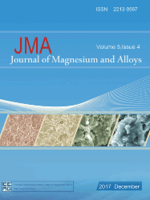
Journal of Magnesium and Alloys
Fostering Collaboration in Cutting-edge Materials ResearchThe Journal of Magnesium and Alloys is a prestigious, peer-reviewed academic publication dedicated to advancing the field of materials science, particularly focusing on magnesium and its alloys. Published by KEAI PUBLISHING LTD since 2013, this Open Access journal enables unrestricted dissemination of research findings, enhancing global collaboration among researchers, professionals, and students. With an ISSN of 2213-9567 and a significant impact factor, it has established itself in the upper quartiles (Q1) of both the Mechanics of Materials and Metals and Alloys categories, ranking #3 out of 176 and #9 out of 398 respectively according to Scopus. The journal aims to provide a forum for the latest advances in the understanding, production, and application of magnesium alloys, fostering innovation and sustainable practices within the materials engineering community. Based in Beijing, China, the journal is committed to bridging gaps in current knowledge and driving future research directions through its high-quality publications.

Corrosion Science and Technology-Korea
Navigating the complexities of corrosion for engineering excellence.Corrosion Science and Technology-Korea, published by the CORROSION SCIENCE SOC KOREA, is a pivotal journal dedicated to the exploration and advancement of knowledge in corrosion science, particularly within the context of materials performance and maintenance. Established to foster innovation and collaboration among scholars in South Korea and beyond, this journal focuses on areas such as electrochemistry, metal alloys, and surface coatings, catering to a diverse audience of researchers, professionals, and students in materials science and chemistry. Despite its current quartile rankings, including Q4 in Electrochemistry and Q3 in various materials-related categories, the journal aims to enhance its visibility and impact in the scientific community by publishing high-quality research and reviews. With its ISSN 1598-6462 and E-ISSN 2288-6524, Corrosion Science and Technology-Korea is committed to contributing to the understanding and mitigation of corrosion issues, thereby promoting sustainability and longevity in engineering applications.
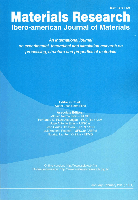
Materials Research-Ibero-american Journal of Materials
Bridging theory and practice in the realm of materials technology.Materials Research-Ibero-american Journal of Materials, published by the UNIV FED SAO CARLOS, DEPT ENGENHARIA MATERIALS, is a prominent platform dedicated to advancing the field of materials science. Launched in 1998, this Open Access journal has fostered a culture of inclusive knowledge sharing, allowing researchers and practitioners worldwide to access valuable insights in Condensed Matter Physics, Materials Science, Mechanical Engineering, and Mechanics of Materials. With a commendable Q3 ranking in these diverse categories in 2023, the journal provides a vital resource that bridges theoretical research and practical applications in materials technology. Covering a range of topics from novel material characterization to innovative engineering solutions, Materials Research serves as a critical forum for contributors across the globe, particularly those in Latin America. Researchers, students, and professionals are encouraged to engage with this journal, which operates with a clear commitment to high standards and is based in São Carlos, Brazil, further enhancing its relevance and appeal within the international materials research community.
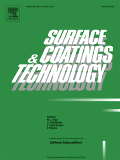
SURFACE & COATINGS TECHNOLOGY
Exploring Cutting-edge Developments in Materials ScienceSURFACE & COATINGS TECHNOLOGY is a premier academic journal that has been at the forefront of research and innovation since its inception in 1986, diligently published by Elsevier Science SA. With an impressive range of studies focusing on surface and coatings technologies, the journal has established itself as a leading platform within the fields of Chemistry, Condensed Matter Physics, and Materials Science. Notably, it holds a distinguished Q1 ranking in multiple categories, showcasing its relevance and high impact in the academic community. Furthermore, it is recognized for its rigorous peer-review process and is indexed in esteemed databases, maintaining its strong position with a ranking of #17 in Surfaces, Coatings, and Films. Although the journal does not currently offer open access options, it continues to be a crucial resource for researchers, professionals, and students seeking insights into cutting-edge developments and applications in the domain of surface engineering. With a commitment to advancing knowledge across these disciplines, SURFACE & COATINGS TECHNOLOGY is an essential read for anyone interested in the latest trends and technologies shaping the industry.
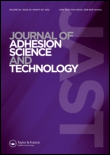
JOURNAL OF ADHESION SCIENCE AND TECHNOLOGY
Exploring Innovative Solutions in Material Interactions.Journal of Adhesion Science and Technology is a distinguished publication within the fields of Chemistry, Materials Science, and Engineering, published by the reputable Taylor & Francis Ltd. Since its inception in 1987, the journal has been pivotal in advancing the understanding of adhesion mechanisms, technologies, and applications, boasting a conversion period extending to 2024. With a commendable impact factor and rankings placed in the Q2 category across various relevant domains, including Mechanics of Materials and Materials Chemistry, it offers a robust platform for scholars and practitioners alike. While currently not an open-access journal, it provides multiple access options, ensuring that vital research in adhesion science remains accessible to those dedicated to innovation and practical improvements in material interactions. This journal not only promotes empirical research but also encourages interdisciplinary collaboration, making it essential reading for researchers, industry professionals, and students eager to contribute to this dynamic field.